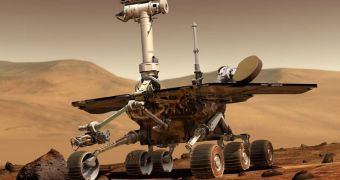After nearly seven years of roaming the surface of the Red Planet, the Mars Exploration Rover (MER) Spirit has finally been declared dead by mission controllers at the NASA Jet Propulsion Laboratory (JPL), in Pasadena, California.
Operational planning activities for the exploration robot have concluded at NASA, and all efforts have now been redirected towards supporting the mission of Spirit's twin spacecraft, MER-B Opportunity.
The separation from Spirit after so many years of continued operations is bittersweet, says its JPL management team, which has been with the rover ever since it landed on Mars, in January 2004.
Since then, it survived a number of Martian winters, despite all odds, and managed to conduct sufficient scientific studies to completely change our perception of our neighboring planet.
JPL experts last communicated with the machine on March 22, 2010, just as winter was setting in at its location, and the amounts of visible sunlight were growing too small to allow further operations.
Earlier this year, as the Martian winter subsided, NASA began conducting listening campaigns, in hope that the rover would once again reawaken. But, despite its best efforts, Spirit remained silent, in the same patch of loose soil that trapped it back in May 2009.
The location, called Troy, was made up of flour-like sand covered by a thin crust. The rover's wheels cracked this hardened surface, and sunk into the loose sands. After months of attempts, the robot could not be budged, and so NASA renamed it into a stationary science platform.
However, due to being trapped, the machine could not make its way to the spot where it was supposed to spend the winter. Its position was very poor, and this may have contributed to its demise.
On the other hand, Spirit endured on Mars for 20 times longer than originally planned, providing a wealth of data that is now informing numerous new computer models depicting Mars' history.
“Our job was to wear these rovers out exploring, to leave no unutilized capability on the surface of Mars, and for Spirit, we have done that,” JPL MER project manager John Callas said recently.
“What's really important is not only how long Spirit worked or how far Spirit drove, but also how much exploration and scientific discovery Spirit accomplished,” he added. The rover traveled 12 times the distance its mission called for. Its odometer now reads 7.73 kilometers (4.8 miles).
During its six years of mission, Spirit's instruments analyzed 15 rock targets, and brushed about 92. At the same time, onboard cameras collected an encyclopedia of 124,000 images and panoramas.
“Spirit's unexpected discovery of concentrated silica deposits was one of the most important findings by either rover,” said MER principal investigator Steve Squyres, who is based at the Cornell University, in Ithaca, New York
“It showed that there were once hot springs or Steam vents at the Spirit site, which could have provided favorable conditions for microbial life,” he concluded.
On the other side of Mars, the rover Opportunity is still on its way to Endeavour Crater. It still has a long way to go, but progress is constant, and the spacecraft is holding up nicely. It is now officially the longest-lived spacecraft on Mars, having exceeded 7 years of continuous mission.

 14 DAY TRIAL //
14 DAY TRIAL //